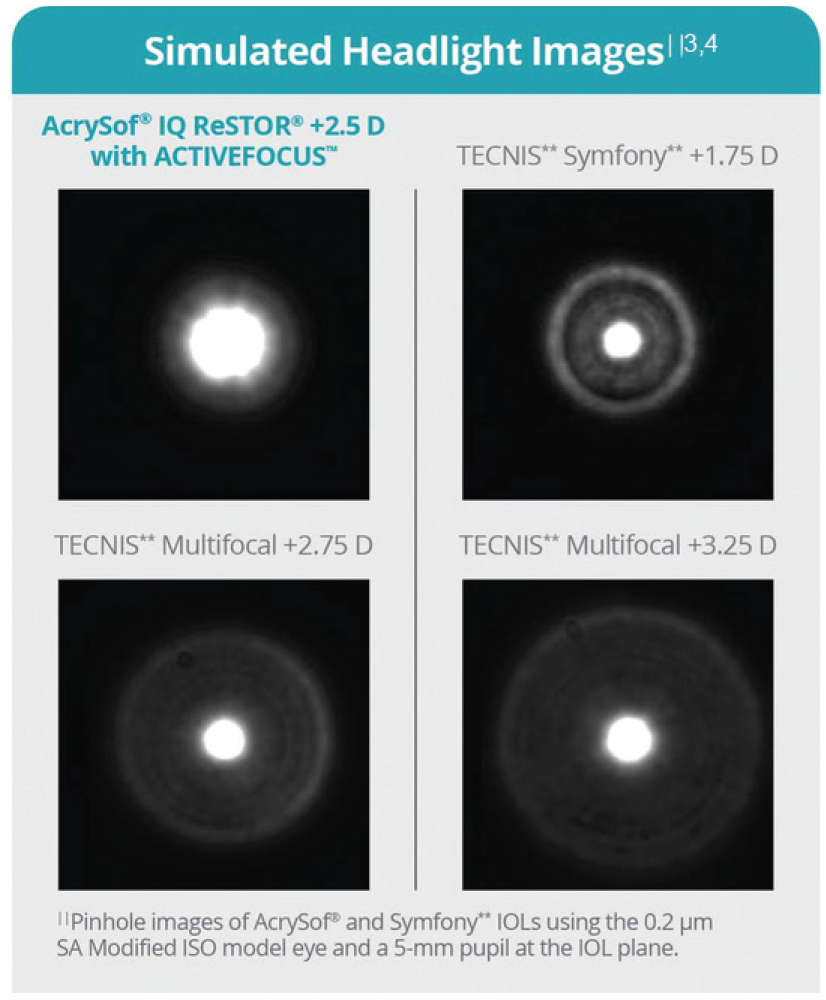Over the years, my patients have been fortunate to achieve great outcomes with various multifocal lenses. The existing technology generally delivered the blend of near and distance vision patients were looking for, albeit often with a degree of compromise in one or more vision zone. However, we would occasionally hear complaints about glares and haloes that sometimes interfered with nighttime driving and other activities.
I am always interested in hearing about ways we can do even better in meeting patients’ vision goals. We are in an era of cataract surgery where we are looking to make stepwise enhancements in refining the outcome. And so, while most of my patients were receiving the postoperative vision they expected after receiving a multifocal implant, I was on the lookout for newer technologies that might reduce the potential for unwanted visual phenomena.
When I learned about the AcrySof IQ ReSTOR +2.5 D IOL with ACTIVEFOCUS optical design (Alcon), two key features suggested it was designed to provide a full range of vision and help reduce the potential for glare and halo:
- Compared with the previous AcrySof IQ ReSTOR lens, the central optic on the current lens with ACTIVEFOCUS optical design is targeted for distance vision.1
- The height between the seven diffractive steps has been reduced.1
Combined, these features help produce a multifocal lens where the distance vision is not compromised at all by the multifocality and the glare-halo profile is comparable to a monofocal lens.2

Figure. The AcrySof IQ ReSTOR +2.5 D IOL with ACTIVEFOCUS optical design is associated with reduced potential to induce troublesome haloing compared with other IOL platforms.3,4
One aspect of achieving success with this technology is matching it with the right patient. A lot of my patients use smart phones, tablets, and computers, meaning they may not need near vision with a focal point suitable for reading newspapers and books. The ACTIVEFOCUS optical design technology provides near vision at about 21 inches,1 which is where most patients are performing near tasks—including looking at the dashboard while driving.
So far, patients in my practice who have received the AcrySof IQ ReSTOR +2.5 D IOL with ACTIVEFOCUS optical design have been very satisfied. I am generally able to achieve 20/20 and J3 postoperative vision and, importantly, I have not had concerns with glare and halo (Figure).3,4 Most patients tell me they can do the majority of their work without glasses.
The AcrySof IQ ReSTOR +2.5 D IOL with ACTIVEFOCUS optical design has filled a gap, providing distance, intermediate, and functional near vision without glasses (for most patients) and with very few of the side effects associated with older model multifocal lenses. The patients in our practice who have received this IOL are some of the happiest postoperative patients I’ve seen, and a number have already recommended it to friends and relatives.
So, why do I use ACTIVEFOCUS optical design technology in my practice? Because an already impressive lens platform has been further refined to help ensure that the patient’s postoperative visual system has the right elements to function as expected and as desired after cataract surgery.
While several factors, including meticulous surgery and the various technology used during the operation, help address some of the traditional risk factors for postoperative refractive surprise, matching patients with the right lens technology will always be fundamental to a good outcome. And that is why the AcrySof IQ ReSTOR IOL with ACTIVEFOCUS optical design is intriguing: Because it is designed to minimize postoperative visual disturbances5 while providing a full range of vision with uncompromised distance,1 I can focus as a surgeon on controlling the other variables that might affect the final vision.
1. AcrySof IQ ReSTOR +2.5 D IOL Directions for Use.
2. Vega F, Alba-Bueno F, Millán MS, Varon C, Gil MA, Buil JA. Halo and through-focus performance of four diffractive multifocal intraocular lenses. Invest Ophthalmol Vis Sci. 2015;56(6):3967-3975 (study conducted with corneal model eye with 0.28μ spherical aberration).
3. Alcon Data on File (May 17, 2016).
4. Carson D, Lee S, Alexander E, et al. Comparison of two laboratory-based systems for evaluation of halos in intraocular lenses. Clin Ophthalmol. 2018;12:385-393.
5. Alcon Data on File (Oct 6, 2016).
AcrySof, ACTIVEFOCUS and ReSTOR are trademarks of Novartis. All other brand/product names are the trademarks of their respective owners.

